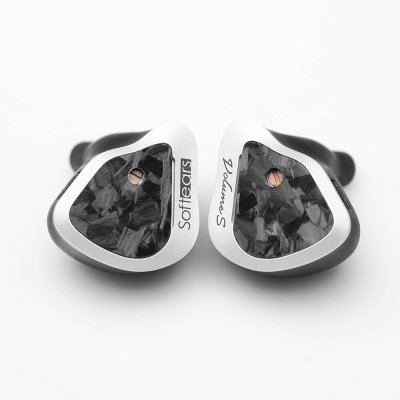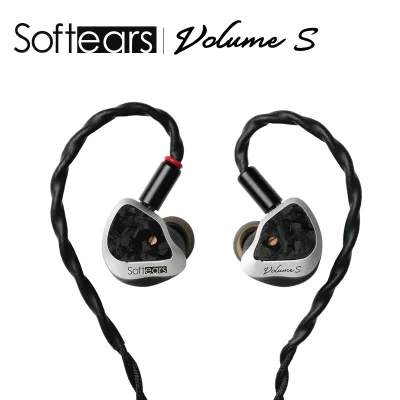Softears Volume S and Yu9 Que use 2DD+2BA and 1DD+3BA driver setups respectively. Softears Volume S costs $320 while Yu9 Que costs $409. Yu9 Que is $89 more expensive. Yu9 Que holds a slight 0.4-point edge in reviewer scores (7.7 vs 8.1). User ratings place Softears Volume S at 8.2 and Yu9 Que at 8.5. Yu9 Que has better mids with a 0.7-point edge, Yu9 Que has better treble with a 0.7-point edge, Yu9 Que has significantly better dynamics with a 1.4-point edge, Yu9 Que has better soundstage with a 0.7-point edge, Yu9 Que has significantly better details with a 1.2-point edge and Yu9 Que has significantly better imaging with a 1.4-point edge.
Insights
| Metric | Softears Volume S | Yu9 Que |
|---|---|---|
| Bass | 8 | 8.2 |
| Mids | 7.6 | 8.3 |
| Treble | 7.3 | 8 |
| Details | 6.7 | 7.8 |
| Soundstage | 7.4 | 8.1 |
| Imaging | 6.5 | 7.9 |
| Dynamics | 6.4 | 7.8 |
| Tonality | 7.8 | 8.3 |
| Technicalities | 7.4 | 8 |
Softears Volume S Aggregated Review Score
Average Reviewer Scores
Average Reviewer Score:
7.7Strongly Favorable
Yu9 Que Aggregated Review Score
Average Reviewer Scores
Average Reviewer Score:
8.1Very Positive
Reviews Comparison
Softears Volume S reviewed by Jaytiss
Jaytiss Youtube Channel
Buy Softears Volume S on HiFiGO
Ad
Price: $290
Buy Softears Volume S on HiFiGO
Yu9 Que reviewed by Jaytiss
Youtube Video Summary
The YU9 Que sports a premium, durable resin shell in pure black with a metallic-feeling faceplate and a comfortable design featuring an anti-tragus catch. While the build itself feels handsome and unique, the included cable is criticized as wimpy and unpleasant, with a strong suggestion to upgrade it. Accessories are deemed solid, including a nice selection of tips and a particularly praised case with a soft, luxurious interior.
Sonically, the YU9 Que earns immense praise for its exceptional tuning, described as clean, resolute, and non-fatiguing. It delivers strong, textured bass that avoids being overwhelming, coupled with extremely well-done upper mids. While not class-leading in technicalities like micro-detail or instrument separation, its tonal balance is considered sophisticated and reminiscent of far more expensive sets like the Annihilator, even surpassing the Monarch MKII in tuning preference. It's highlighted as a fantastic all-rounder with a smooth, agreeable signature suitable for long listening sessions.
Despite its modest single dynamic driver + 3BA configuration and $409 price point, the YU9 Que is declared a very special and unique IEM, worthy of the hype it received. The review concludes it's a price leader and a highly competent package from a small brand, offering outstanding value and a beautiful, well-executed design that makes it an easy recommendation for those seeking a smooth, non-fatiguing sound.
Jaytiss Youtube Channel
Softears Volume S reviewed by Audionotions
Yu9 Que reviewed by Audionotions
Softears Volume S reviewed by Gizaudio Axel
Gizaudio Axel original ranking
Gizaudio Axel Youtube ChannelYu9 Que reviewed by Gizaudio Axel
Youtube Video Summary
Build & accessories: a hybrid 1DD + 3BA set priced around $399 with a spacious zipper case, multiple silicone tips, pouches, cleaning cloth, and shirt clip. The faceplate’s wavy, stone-like texture looks premium, and the shells use a 2-pin connector. The downside is the stock cable: it’s springy, only in 4.4 mm, and feels below the tier. Fit is serviceable but not ideal—the shell isn’t the most ergonomic, the nozzle lacks a lip, and seating a deeper fit can take a moment; once set, stability is good and tips stayed secure in use.
Sound: this isn’t a “new-meta” curve; it’s a unique, lively tuning. Bass is punchy, dynamic, and highly textured—more physical in practice than the graph suggests, with excellent impact and kick-drum authority. An early rise after 1 kHz pushes vocals front and center for an intimate, engaging presentation without tipping into shout. Treble is refined, sparkly, and well-extended: it is a bright set but avoids harshness, peakiness, sibilance, and fatigue, delivering crisp cymbals and defined transients even for rock and metal at any volume. Technicalities are class-leading under $500 with standout detail retrieval and separation; the one wish is a larger soundstage.
Comparisons & verdict: the Elysian Apostle still wins on bass texture/impact, treble refinement, and overall resolution, but the Yu9 Que offers a convincing “Apostle flavor” at a lower price. Versus Elysian Pilgrim, the Que is fuller and bassier, while Pilgrim’s treble is tamer; versus Volume S, the Que is cleaner, brighter, more detailed as the Volume S trends warmer with more neutral treble; against Dusk DSP, Dusk sounds more natural/balanced but the Que feels more fun and technical. Recommended for those who crave clarity, sparkle, and engagement without fatigue; less ideal if treble-sensitive or preferring a warm, relaxed tonality, and worth demoing for comfort. A top contender and serious gatekeeper around $400—final rating: 4.5/5 with a strong recommendation.
Gizaudio Axel original ranking
Gizaudio Axel Youtube ChannelSoftears Volume S reviewed by Jays Audio
Youtube Video Summary
The Softears Volume S emerges as a standout vocal specialist under $500, often described as a "mini studio 4“ due to similar frequency graphs. However, it trades some treble detail for superior scaling and a heightened focus on the mid-range, particularly vocals, while adding a touch more mid-bass oomph. This treble reduction allows the music to breathe, creating a more immersive and musical experience that pulls the listener deeper into the sound compared to the Studio 4, without sacrificing a sense of space or leaving the bass and treble feeling inadequate. Though not bass-heavy or treble-head oriented, the low-end provides enough thump and the highs enough air to avoid sounding lean or dark, resulting in a presentation that's slightly less technical and balanced than the Studio 4 but excels in vocal delivery and engagement.
A key feature is the tuning switch which boosts upper mids and treble while lowering the bass, effectively transforming the sound into a cleaner, more technical version of Harman 2019, even surpassing the Studio 4 in detail retrieval in this mode. However, this boosted configuration can sound shouty, lean, and overly clinical for many preferences, lacking the thickness of the stock tuning and scaling less effectively at higher volumes. The stock tuning, preferred for its vocal prowess, truly comes alive with increased volume. The included clear tips are recommended for a slight treble lift and comfort, and the bundled USBC adapter adds a subtle amount of sub-bass rumble, though the low-end remains clean and controlled, reminiscent of leaner sets like the Pilgrim, not providing heavy slam.
While the Studio 4 remains a solid, well-balanced all-rounder, especially on sale around $350, and alternatives like the EM10 (more detailed), Supermix 4 (better value), the Volume S carves its niche with exceptional vocal performance at higher volumes using the stock tuning. Its main drawbacks involve the confusing switch design (requiring opposite positions on each earpiece for the same tuning with no clear indicators) and the pricing debate; using non-branded drivers suggests a more appropriate price point would be $200-$250 rather than $300. Despite these quirks and marketing claims about the passive radiator's role (its actual impact being debatable), the Volume S delivers a great sounding, flexible IEM offering distinct sonic profiles based on volume level and switch position.
Jays Audio Youtube Channel
Yu9 Que reviewed by Jays Audio
Youtube Video Summary
YU9 Que presents a balanced, almost neutral tuning with a tasteful touch of mid-bass for warmth and punch. Treble is clean and controlled—more clarity than “sizzle”—so detail comes through without harshness, while mids keep vocals natural rather than forward or thin. Technical performance sits in the “solid for the price” camp: separation and imaging are tidy, but not the kind of hyper-etched sparkle that chases wow factor.
In practice, it shines with slower pop, R&B, acoustic and vocal-centric tracks where its coherence and smoothness pay off; those seeking big sub-bass drama or ultra-aerated treble fireworks may find it a touch polite. Versus brighter, more contrasty sets, the Que trades spectacle for musicality and long-session comfort, making value hinge on whether a refined, low-fatigue signature is preferred over maximum excitement at the price point.
Jays Audio Youtube Channel
Softears Volume S reviewed by Paul Wasabii
Youtube Video Summary
Softears Vol S leans into a mid-bass emphasis that is uncommon among recent hybrids, pairing boosted sub- and mid-bass with full-bodied, lower-mid vocals. The result is a naturally thick, lush midrange that favors genres needing body over sparkle, and the relaxed treble beyond ear-gain lets volume changes scale bass and treble together. At higher listening levels the set can hit hard and verge on bass fatigue, but within moderate levels it fills a clear gap left by leaner U-shaped tunings.
Trade-offs are plain: the upper-treble sits back, so stage is smaller and overall resolution is lower versus airier peers; some upper-end information gets masked by the bass weight. The impedance switch adds a bit of brightness but also trims the pleasing volume scaling, bringing limited benefit. Not a $300 class leader, yet a well-tuned alternative for listeners who prioritize natural, weighty mids over maximum air and sparkle.
Paul Wasabii Youtube Channel
Yu9 Que reviewed by Paul Wasabii
Youtube Video Summary
At ~$400, YU9 Audio Que sets a new bar for the bracket: a 1DD+3BA hybrid with a modest bass shelf, slightly forward mids, and linear treble extension that sounds more speaker-like than typical IEMs. The presentation is exceptionally polished and quiet-backgrounded, yielding crisp separation, convincing imaging, and staging in depth, width, and height that resembles far pricier gear.
The low end brings tactile mid-bass impact with deep, controlled sub-bass, pairing naturally with that extended, peak-free top end; the result is a true playlist killer across EDM, rock, vocal, and classical. Nitpicks exist: mids can sit a touch forward depending on track and the set rewards a slightly higher volume and a secure, deeper fit, while V-shape fans may find it too boring.
Compared with favorites like Dusk, Cadenza 4, and Volume S, Que keeps their strengths but fixes common complaints by delivering fuller bass weight, cleaner openness, and more realistic attack and dynamics. It does not need giant-killer claims to stand out; at this price it is simply class-leading.
Paul Wasabii Youtube Channel
Softears Volume S reviewed by Head-Fi.org
Yu9 Que reviewed by Head-Fi.org
Softears Volume S (more reviews)
Softears Volume S reviewed by Audio Amigo
Youtube Video Summary
Softears Volume S follows the 2022 Volume and steps into a fiercely competitive ~$320 bracket with a seriously premium kit: a gorgeous leather case, modular screw-on terminations, both standard and Ultra Clear eartips, IM booties, and tiny screwdrivers for the on-board potentiometer. The stealthy black resin shells with exposed carbon-fiber faceplates feel solid and fit well thanks to slim nozzles; just note there’s no nozzle mesh. The big caveat is the cloth-sheathed stock cable—ergonomically nice but with heavy microphonics. Two tunings are selectable: low-impedance (≈10Ω) and high-impedance (≈31Ω). The low-impedance mode is the keeper; it’s easy to drive yet sensitive to source output impedance, so a dongle under 1Ω is recommended to avoid unintentionally shifting the tonality.
In low-impedance mode the signature is neutral-natural, a flatter, more mid-centric take on “new-meta.” Bass offers quality over quantity: textured, punchy, and responsive without tipping into basshead territory. The mids are the star—clean, warm-tinged lower mids give male vocals body while female vocals sit forward without shout, keeping timbre natural. Treble is smooth, airy, and non-fatiguing, avoiding metallic glare while preserving sparkle. Technical performance is confidently above average for the price: imaging & stage feel wide and well-layered, with good separation and resolution that rewards attentive listening without forcing it.
Positionally, think “Kato upgrade”: smoother treble, better bass texture, and a refinement that many will prefer. Versus spicier rivals like DaVinci, Project Meta, Dusk DSP, or Mega 5 EST, the Volume S sounds more controlled and “correct,” trading some slam and upper-air fireworks for coherence and timbre. It won’t thrill bass lovers, treble heads, or detail chasers seeking a spotlighted presentation; everyone else gets a superb all-rounder that feels benchmark-worthy—the HD600/650 vibe for IEMs. Verdict: you should buy this if a do-it-all, neutral-natural tuning is the goal; just mind your source impedance and consider swapping the cable to kill the microphonics.
Audio Amigo Youtube Channel
Softears Volume S reviewed by Super* Review
Youtube Video Summary
The Softears Volume S at $320 sets a new tonal benchmark for IEMs in its price range. It arrives in solid packaging featuring a zippered carry case (a bit large but functional), protective earpiece pockets that might feel overkill for some, and two excellent sets of ear tips – including Softears' own highly-regarded Ultra Clear tips. Build quality is generally fantastic, highlighted by a resin shell, a comfortable paracord-style cable with a low-profile, user-swappable termination system, and recessed 2-pin connectors. While the aesthetics might feel a bit old-school to some, the fit is comfortable and stable due to its semi-custom shape and longer nozzle, making it secure enough for sleeping. A small screwdriver-adjustable tuning switch offers a secondary, brighter Harmon-like sound signature, though the default tuning is preferred.
The default sound signature is a warm-tilted neutral, delivering exceptional natural timbre and tasteful bass boost. This bass stands out for its exceptional physicality – punchy and impactful without being overbearing – alongside articulate sub-bass that’s easy to follow. Combined with well-defined transients, particularly in the upper-midrange, it creates a satisfyingly rich and dense presentation. While spatial effects and imaging are competent but not standout, the overall tonality and bass quality are remarkably refined. Comparisons show it offers a better tonal balance and bass control than the bassier Dunu DaVinci, significantly more body and richness than the brighter, thinner Moondrop Blessing 3, and trades blows with the Moondrop Dusk – the Volume S providing superior density and mid-bass presence versus the Dusk's more open, spacious presentation.
Ultimately, the Softears Volume S earns a full five-star rating. It might not be the absolute most technically dazzling IEM, but its fantastic tonal balance, unique bass physicality, and overall refinement make it a compelling choice. For $320, it delivers a sound signature that feels just right – rich, satisfying, and universally appealing – challenging more expensive offerings and establishing itself as a top contender in its class.
Super* Review original ranking
Super* Review Youtube Channel
Softears Volume S reviewed by
 Fresh Reviews
Fresh Reviews
Youtube Video Summary
The Softears Volume S delivers a fantastic hybrid sound in its low impedance mode, characterized as a warm neutral tuning with a lush note weight, good bass punch without bloat, and a slight upper-midrange emphasis that makes vocals pop. This signature translates exceptionally well across both music listening and competitive gaming, offering great separation, layering, and phenomenal imaging for precise positional awareness. While engaging and non-fatiguing, gunfire and intense effects in games like Apex Legends can sometimes feel on the verge of shouty or slightly occlusive during chaotic, high-level scenarios, lacking that last bit of air and resolution in the upper mids.
Gaming performance shines across multiple titles. The Volume S provides outstanding depth perception and accurate imaging for Apex Legends slides and light footsteps, excels in Valorant with its separation and verticality, handles the chaos of Call of Duty exceptionally well, and proves to be a top recommendation for Fragpunk due to its loud, precise, and easily trackable footsteps. The smaller resin chassis offers great comfort and ergonomics, especially for those struggling with fit, though it doesn't feel quite as premium as some metal competitors in its price range.
Significant drawbacks include the utterly dismissed high impedance mode tuning, deemed "absolute garbage" and a headache for gaming, and the fragile tuning mechanism itself, prone to easy damage. The included shoelace-style cable is functional with a removable termination but not a favorite, and the unboxing experience, while decent with a pleather case, extra termination, and two sets of silicone tips, is fairly typical for the price. Ultimately, the Softears Volume S stands as a killer all-around IEM when locked into its excellent low impedance mode, highly recommended for its crossover appeal despite the useless tuning switch and build quibbles.
Fresh Reviews original ranking
Fresh Reviews Youtube ChannelSoftears Volume S reviewed by Z-Reviews
Youtube Video Summary
The Softears Volume S offers a dramatic transformation through its impedance switch, requiring a tiny screwdriver to toggle between low (9.8 ohm) and high (31.2 ohm) modes. The low impedance mode is described as painfully clinical, bland, and annoyingly sterile across all tested amplifiers. It’s reminiscent of the disliked original Volume model, lacking any enjoyable tuning despite EQ attempts. This mode only suits listeners craving absolute neutrality, offering little musical engagement.
Switching to the high impedance mode completely revolutionizes the experience. It becomes relaxed, unoffensive, and remarkably smooth, with notes possessing a lingering, church-like resonance that adds emotional depth. This mode presents music with a spacious, uplifting quality and a subtle chest-felt pressure during resonant passages. However, it demands quality amplification to shine and benefits from tip-rolling; the included sticky liquid silicone tips enhance the signature, though alternatives like Azla SednaEarfit can tweak the response. Comfort and build are excellent, though the fabric cable exhibits some microphonics.
Priced around $300, the Volume S earns a cautious recommendation primarily for its stellar high-impedance performance. It requires tinkering with tips and sources to reach its potential and faces stiff competition in its price bracket. While not an outright class leader, it’s a significant upgrade over the original Volume. The package includes a luxurious case, multiple tips, and a branded USB-C adapter, reflecting Softears' typical attention to detail. Just keep it locked in high-impedance mode.
Z-Reviews Youtube Channel
Softears Volume S reviewed by Tim Tuned
Youtube Video Summary
The Softears Volume S delivers a distinctly colored sound signature with significant boosts in two key areas: the bass and the upper mid-range. Its bass profile is uniquely elevated up to around 300Hz, resulting in a physical, heavy, yet well-defined low end that impresses with substantial note weight and attack, appealing even to bass enthusiasts. Vocals cut through clearly due to the upper mid-range boost, but this tuning comes with a trade-off: a noticeable sense of hollowness and a narrower soundstage that can feel congested on certain tracks, creating a love-hate relationship with its presentation.
The treble offers a safe, natural, and polite character, providing adequate detail without excessive brightness or roll-off, though it may lack sparkle for some listeners. Technically, the Volume S performs at a level comparable to the Moondrop Blessing 3, excelling particularly in the incisive attack and substantial weight behind each note. When compared to competitors, the Volume S edges out the Tea Pro in bass quality, separation, and natural timbre, though the Tea Pro offers a wider stage. Against the Blessing 3, the Volume S trades openness and cleanliness for a more fun, bass-forward and impactful experience. It also presents a more balanced signature than the brighter, more treble-focused Kiwi Ears Astral.
Ultimately earning an A-minus rating, the Volume S is highly recommended for those seeking exceptional bass quality and a fun, colored tuning. However, it might not suit listeners prioritizing a wide soundstage, a neutral signature, or a bright, sparkly treble with forward micro-details; these listeners are advised to audition first.
Tim Tuned Youtube Channel
Softears Volume S reviewed by Smirk Audio
Yu9 Que (more reviews)
Yu9 Que reviewed by Fox Told Me So
Tuning is clean, neutral, and slightly V-shaped: bass is tight, bouncy, and textured; mids sit slightly forward thanks to extra 700 Hz–2 kHz gain, giving vocals a bigger image; treble leans bright with a 4–5 kHz push for clarity, rolling off naturally rather than chasing EST-style air. Sibilance can appear (on “th” or “tsu”), but not harsh.
Stage favors width over depth—impressively wide at the price, with neat, well-ordered placement and strong separation. Resolution is crisp, background clean, every note clearly etched.
Fox Told Me So original ranking
Fox Told Me So Youtube ChannelYu9 Que reviewed by Kois Archive
Youtube Video Summary
Yu9 Que arrives with a surprisingly premium unboxing: a crush-resistant carrying case with plush padding, an IEM pouch, microfiber cloth, cable clip, and two ear-tip sets (standard silicone and more premium liquid silicone). A quirky 3D-printed nameplate with serial number and a faceplate etched in a topographic-map motif give it character. The shell is on the larger, wider side—comfortable for many, but small ears should test fit first. The stock cable is just okay (some memory, no chin slider), though it’s offered in 3.5 mm or 4.4 mm terminations.
Tonally, this is a neutral-reference set with a tasteful bass lift—clean impact without throwing off balance. Sub-bass has satisfying thump and texture, though bass-heads coming from sets like Kiwi Ears Punch may find it polite. The mids sit even and accurate—no “vocal magic,” yet clearly above average. Treble stretches well into the air with a touch of brightness that adds crispness and a slightly clinical edge, staying shy of fatiguing. Technical chops are the draw: a decently wide soundstage (roughly 3–4/5 by comparison), standout 3D imaging, and strong resolution/separation make it excellent for gaming—worthy of a two-controller nod—though ultimate detail still trails pricier kilobuck options.
Versus peers: Moondrop Dusk (DSP) is warmer with bass that hits a bit harder, while Yu9 Que is the more neutral, reference-leaning take. Elysian Pilgrim offers smoother treble, but Yu9 Que counters with better bass grip, stage, and imaging. AFUL Performer 7 tilts mild V; choose it for extra mid-bass and forward treble, otherwise Yu9 Que wins on technicality. Mega 5 EST chases the meta target yet stumbles in bass/treble; NiceHCK Rockies refines that approach and might be the more exciting alternative if spending slightly more. Bottom line: the hype is justified—a superb all-rounder around $400 with only the cable begging for an upgrade. It’s a clear pick for neutral/reference fans, though those seeking more “fun” might look elsewhere; call it a pragmatic, two-star recommendation amid a crowded market and likely pre-order waits.
Kois Archive Youtube Channel
Yu9 Que reviewed by Precogvision
Youtube Video Summary
Yu9’s Que lands as a “safer Annihilator”: a warmer, scaled-back take that pushes ample sub-bass while keeping the rest tastefully controlled. The low end feels liquidy and bouncy, underpinning an aggressive 1–3 kHz rise with a gentle 3–5 kHz taper, so vocals sit upfront and crisp yet remain remarkably smooth thanks to the extra low-end warmth. Treble is slightly scooped around 5–6 kHz and then climbs in small, well-placed peaks out to ~15–18 kHz, yielding excellent extension that feels on par with sets like Moondrop Variations in this range.
What makes it pop is the value proposition: at $400, the overall resolution, tonal balance, and staging read far pricier—more like the $700–800 bracket. With its engaging sub-bass lift, lucid mids, and airy yet controlled top end, Que comes off as a polished, crowd-friendly tuning that still excites detail chasers. If momentum holds, this looks like the next big thing around the $400 mark.
Precogvision Youtube Channel
Yu9 Que reviewed by Web Search
The YU9 Que is a hybrid IEM using 1 dynamic driver + 3 balanced armatures, positioned in the mid-upper price tier with an MSRP around $399. Retail listings confirm the configuration (10 mm LF DD with three Knowles BA units) and current pricing in USD and MYR, placing it among competitors that emphasize tonal refinement over sheer technical fireworks.
Community impressions describe a balanced/neutral tonality with a tasteful bass lift, smooth upper-mids that avoid glare, and treble that leans non-sibilant. Subjective reports on Head-Fi and Reddit consistently frame the Que as an all-rounder that favors coherence and long-term listenability over maximum micro-detail.
Technically, listeners note solid imaging and macrodynamics with competent detail retrieval, though not class-leading for the price. The manufacturer has also published frequency-response plots (IEC711 and BK5128 rigs), which aligns with the community’s take that the Que targets a broadly neutral/balanced signature rather than an aggressive V-shape. Overall value is credible at its MSRP if you prioritize tonal balance and comfort over ultra-analytical presentation.
Softears Volume S Details
Driver Configuration: 2DD+2BA
Tuning Type: Neutral with Bass Boost
Brand: Softears Top Softears IEMs
Price (Msrp): $320
Support our free service! Buying through our affiliate links costs you nothing extra:
Yu9 Que Details
Driver Configuration: 1DD+3BA
Tuning Type: Neutral with Bass Boost
Brand: Yu9 Top Yu9 IEMs
Price (Msrp): $409
Support our free service! Buying through our affiliate links costs you nothing extra:
Softears Volume S User Review Score
Average User Scores
Average User Score:
Based on 2 user reviews
8.2Very Positive
Yu9 Que User Review Score
Average User Scores
Average User Score:
Based on 1 user reviews
8.5Excellent
Softears Volume S Gaming Score

Gaming Score & Grade
- The gaming score is prioritizing technical capabilities of the IEM (Separation, Layering, Soundstage) and good value.
Gaming Score
8.3Gaming Grade
A+Yu9 Que Gaming Score

Gaming Score & Grade
- The gaming score is prioritizing technical capabilities of the IEM (Separation, Layering, Soundstage) and good value.
Gaming Score
7.9Gaming Grade
ASoftears Volume S Scorings
Average Technical & Tuning Grades
Average Tunign Grade
A- Tuning feels well executed, keeping a natural flow across the spectrum. Switching genres feels seamless.
Average Technical Grade
A-- A competent technical showing keeps separation intact while delivering modest staging. It feels tidy even when recordings stack layers.
Yu9 Que Scorings
Average Technical & Tuning Grades
Average Tunign Grade
A+- Tuning feels refined, blending frequencies with convincing realism and engagement. Transitions between registers feel effortless.
Average Technical Grade
A+- You get an articulate, polished performance with immersive stage depth and great control. There's a sense of polish across the whole spectrum.
Softears Volume S User Reviews
Share your experience and build your personal ranking list.
You need to be signed in to write your own reviewA well-rounded, coherent IEM that shines in low-impedance tuning with excellent midrange clarity.
Pros
Balanced, natural midrange with solid bass and rich accessories.Cons
High-impedance mode feels unnecessary and shells may be bulky for small ears.RSV with more bass quantity and better quality, at less than half the price.
Pros
Very nicely balanced sound signature for all-rounder duties, with tonality and technical performance that punches above its price. More even sub - mid bass profile which results in a more cohesive, better textured bass vs harman/meta tuned sets.Cons
Pinna gain isn't an ideal fit for my HRTF, hearing slightly too much upper-mid emphasis after extended listening and comparisons. Upper treble is lacking air vs more expensive sets, most evident in cymbal hits coming across dulled, not unlike the RSVYu9 Que User Reviews
Share your experience and build your personal ranking list.
You need to be signed in to write your own reviewTastefully tuned IEM. It gives some unique colorations to the sound, making vocals sound pretty crisp and clean but in a tasteful way. Add a very satisfying amount of bass (including mid-bass!). Treble is top-notch.
Pros
Tuning, especially bass and treble. But mids do not disappoint as well.Cons
I wouldn't describe this as neutral or even reference sounding. Soundstage could be wider.Find your next IEM:
IEM Finder Quiz
newIEM Comparison Tool
newVS


































